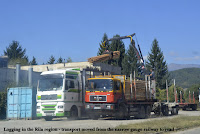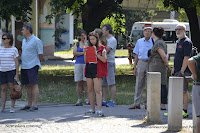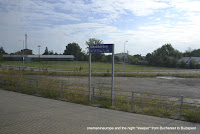Into the forest...
We emerge from the car park and turn right? Ah, petrol is required for our journey. Pulling in to the modern service station about 500 metres down the road I observe the transfer of logs from a small lorry suitable for accessing the forest to a large road transporter which may whisk its load across the highways of the European Union. The disused flatbeds scattered along the once busy and prosperous narrow gauge railway reflect this change. It also goes to show that, whereas the logs would have been collected from local halts then transferred at the end of the line which kept the smaller stations and local support alive, the logs still have to be handled multiple times and many more trucks poured onto the roads. I hope that the tide is turning throughout the world, that rail and water will re-emerge as the sensible option. But onward to find our bears....
We skirt around the pedestrianised Belitsa town centre where I managed to shoot a quick photograph then bump down dusty minor roads climbing into the forest pass in old barn and other structures reminiscent of farming in rural areas of France and, once upon a time, England too. A thirty minute dusty ride brings us to an electric fence and a car park at the entrance to the Bulgarian Dancing Bear Sanctuary. Passing through the entrance, enclosed by high fences our the view was dominated by an imposing wood clad observation building. As we are at the top of the park this combines a magnificent viewing platform which extends out over the sanctuary, lecture theatre and displays. It also houses the support requirements of the staff.
The staff are very friendly and helpful. They suggested I watch a video in the theatre which would explain, in English, the remit, structure and other information about the park. After watching the video I perused the photos and information boards. The happy dancing bear is a myth, the vast majority were ill treated and kept in inadequate quarters. The project originally rescued "dancing bears" from within Bulgaria. This expanded to encompass bears kept in captivity such as the cuddly bear cub kept in a restaurant's small cellar as an attraction. Unfortunately cubs grow and this one outgrew its "cave" but could not escape. It is now living a happy life in the sanctuary. The bears have to learn to live in the "wild" made more difficult by the fact that many only have three paws. In many cases the circulation to the leg was restricted or infected by the securing chain with obvious results. In 2007 the last dancing bears were freed. Some have now rescued from neighbouring Serbia.
There is also a model of the sanctuary clearly displaying the layout from the observation building at the top down to the "hospital" at the bottom. But where better to see what is going on than by climbing the steps to the roof platform above my head. The structure extends over the side of the hill affording an ample view of the park and the three nearest enclosures. We were fortunate to be there at lunch time. The teddy bears picnic consisted of slices of bread and the bears were very dexterously cutting off the crusts which they seemed to discard, just like children enjoying their freedom.
Visitors can spend as long as they like observing the bears from the platform and are called when one of the foot tours is about to start. There is a long and a short tour of the park lead by the very informative and enthusiastic staff. On arrival you are given the choice. The fencing creates some difficulty in trying to photograph the bears but the experience is thrilling. Unlike a zoo the acreage is very carefully calculated to afford a natural habitat. Unfortunately this limits the number of bears which can be rescued.
The sanctuary houses 26 bears in 7 areas, 6-7 bears to an area to give adequate space. The habitat is carefully has been designed and developed over the years to simulate the natural habitat of brown bears in the wild. Swimming pools, forest shadow, meadow and caves. The Sanctuary covers 120000 sq metres, or 12 hectares, surrounded by electric fence. This protects the bears from poachers and legitimate visitors to the park. New arrivals are introduced to a small compound as they need to learn to forage for their food and generally survive in the "wild". It also allows the resident vets to treat any ailments or disease before they join one of the main sloths.
They are fed three times a day. When the park first opened they were only fed once a day but, as studies proved that wild bears need to hunt for food just as they need a natural habitat, this was changed to three times a day. The food is hidden in different places which the bears initially use their sense of smell to locate. The diet consists of vegetables & fruit in the morning, lunch is bread, and dinner of fish and nuts depending on season. the ratios of rationing are 5 - 10 - 20 kg.
There are two blind bears in the sanctuary, located in the first compound at the bottom of the hill. Introduced separately they have become firm friends both of each other and of the staff working in the adjacent "Animal hospital". Unfortunately I didn't manage to capture them on camera. An amazing experience and well worth the effort. I discovered later that there some excursions to the sanctuary during the tourist seasons organised by external companies.
We departed and headed back down the trail continuing my extended adventure in the vicinity of Belitsa and the narrow gauge railway. The sun shining, a gentle breeze and the start of an interesting journey back to my hotel in Dobrinshte. Unfortunately not by this tranquil mode of transport but by car, a contrast to the train. My photo album can be viewed here. As they say on the small screen, to be continued...
We skirt around the pedestrianised Belitsa town centre where I managed to shoot a quick photograph then bump down dusty minor roads climbing into the forest pass in old barn and other structures reminiscent of farming in rural areas of France and, once upon a time, England too. A thirty minute dusty ride brings us to an electric fence and a car park at the entrance to the Bulgarian Dancing Bear Sanctuary. Passing through the entrance, enclosed by high fences our the view was dominated by an imposing wood clad observation building. As we are at the top of the park this combines a magnificent viewing platform which extends out over the sanctuary, lecture theatre and displays. It also houses the support requirements of the staff.
There is also a model of the sanctuary clearly displaying the layout from the observation building at the top down to the "hospital" at the bottom. But where better to see what is going on than by climbing the steps to the roof platform above my head. The structure extends over the side of the hill affording an ample view of the park and the three nearest enclosures. We were fortunate to be there at lunch time. The teddy bears picnic consisted of slices of bread and the bears were very dexterously cutting off the crusts which they seemed to discard, just like children enjoying their freedom.
There are two blind bears in the sanctuary, located in the first compound at the bottom of the hill. Introduced separately they have become firm friends both of each other and of the staff working in the adjacent "Animal hospital". Unfortunately I didn't manage to capture them on camera. An amazing experience and well worth the effort. I discovered later that there some excursions to the sanctuary during the tourist seasons organised by external companies.
We departed and headed back down the trail continuing my extended adventure in the vicinity of Belitsa and the narrow gauge railway. The sun shining, a gentle breeze and the start of an interesting journey back to my hotel in Dobrinshte. Unfortunately not by this tranquil mode of transport but by car, a contrast to the train. My photo album can be viewed here. As they say on the small screen, to be continued...












Comments
Post a Comment